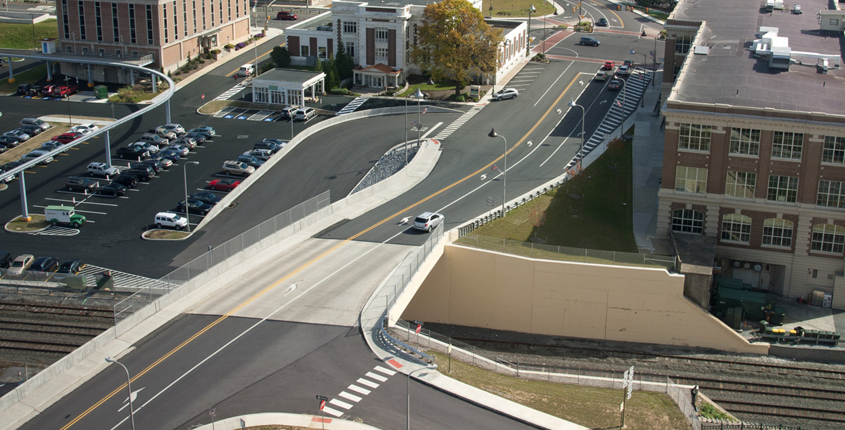How to Get Grant Money for Your Infrastructure with Asset Management and Capital Improvement Planning
April 30, 2015 /
Historically, the approach to infrastructure assets has been the proverbial, “If it ain’t broke, don’t fix it.” The result is that nationwide our infrastructure is in need of repair, and government officials at every level are talking about how to change this approach. While the legislators negotiate a funding solution, local and county officials can start preparing now to position their projects for infrastructure funding when it becomes available. One way to do this is by implementing an asset management and capital improvement program.
A good asset management program collects data about a government’s infrastructure and its condition; identifies the appropriate type and timing of maintenance, restoration, or replacement measures; and ranks those needs based on the condition of the infrastructure and its function in the community. (i.e. How disruptive would the impact be if this infrastructure failed?)
When the asset management plan is augmented with planning-level cost estimates, the result is a good forward-looking capital improvement program.
So why are asset management and capital improvement programs so important to governments seeking state and federal funds?
Capital improvement programs give you plenty of time to pursue your funding options, (and you just might need it.)
Some state agencies plan their funding expenditures years in advance. (For instance, PennDOT programs roadway and bridge project funding needs into its 10-year Transportation Improvement Plan.) It can sometimes take more than a decade to obtain the funds needed for an infrastructure improvement project, so local governments must have a capital improvement program in place that continually monitors the condition of their infrastructure and prioritizes projects for repair and replacement, according to need. If a community waits until a sewer line breaks or a bridge must be closed, there may not be time to line up the assistance needed to address it.
A good capital improvement program will identify infrastructure needs years in advance and will estimate the anticipated funding requirements. This gives local officials the time to develop funding solutions and work the appropriate channels to pursue sources of cash, grants, and subsidized loans, etc.
Capital improvement programs are a great tool for gaining support for a project, which can bring other partners to the table in seeking funding options.
A good capital improvement program demonstrates how badly an infrastructure improvement project is needed, who will benefit from the project, and how much it will cost. Most importantly, it demonstrates why the project cannot be ignored. Local officials can use this information to gain public support for a project and recruit community partners such as local businesses and non-profit organizations to help lobby agencies for funding. The more voices an agency hears in support of a project, the more likely they are to consider it significant to the community (and the harder it will be to ignore.)
Capital improvement programs provide the data for strong funding applications.
With a good capital improvement program in place, local governments will have plenty of data at their fingertips about how many people rely on that infrastructure and how they would be impacted by it being taken out of service. Including that information in your funding application is important. If you were a funding agency official considering two applications – one that clearly outlined how many people would benefit from the project and one that didn’t – which would you choose?
Capital improvement programs help you prove that your project is a good investment.
Funding agencies must demonstrate that the money they spend gets results, so the last thing they want is to allocate their money to a project that will never be built or will languish for years with delay after delay.
A well-executed capital improvement program will determine exactly what is required to get a project completed, including the timelines for permits and approvals that could slow a project down. A funding application that demonstrates that level of detail will reassure agencies that the money they invest will be used wisely and the project will be completed without issue.
A good example of how capital improvement plans help a local government obtain funding is the Route 743 Bridge over the Norfolk Southern Railroad in Dauphin County.
Through capital improvement planning, local officials in and around Hershey, PA identified this structurally deficient bridge’s importance to the community was significant: 12,000 vehicles per day travel across that bridge, including the trucks that deliver Hershey chocolates from its factory across the railroad to America’s eager hands. Local officials put together a group of stakeholders to pursue funding for the project, which included local business leaders, and, after more than a decade of hard work, the group had assembled a funding package from multiple sources to make this $10 million project a reality. One of the stakeholders in that group was Dauphin County Commissioner Jeffrey Haste, whose county has successfully used capital improvement planning for the past 25 years to replace all of its structurally deficient bridges.
“You really have to have your ducks in a row when you apply for funding,” says Haste. “You have to show exactly why the project is needed, who it will benefit, and how it will be accomplished.”
Does your community have an asset management/capital improvement plan in place?
Learn more about asset management and capital improvement planning in the webinar by Ben Gilberti and Rob Arnold below.



